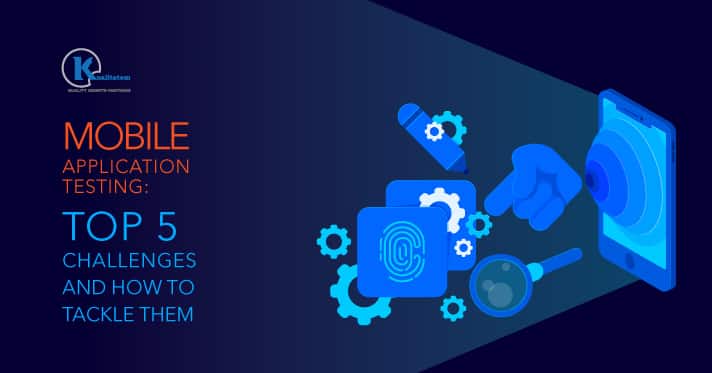Mobile App Testing: Top 5 Challenges and How to Tackle Them

- December 17, 2018
- HibaSulaiman
According to statista’s report, in 2017 alone, consumers have downloaded more than 175 billion mobile apps. The cost of developing a mobile app can go beyond $1 million, with an average cost ranging between $100,000 to $500,000. Multiply these numbers and you’ll get an idea on the astonishing amount spent on resources yearly merely on mobile app development.
The bad side? Most of those resources switch jobs in the middle of the task.
Organizations dedicate a good number of resources for mobile app development only because of the business enhancing and customer growth potential offered by the smartphone industry. On average, consumers in the U.S alone spend approximately five hours every day on their mobile devices. And that more than 85% of that total time is spent on interacting with apps.
It doesn’t come as a surprise that companies primarily want their customers to spend major time using apps that they build. But this is only achieved if they manage to give their customers a 100% functional, user-friendly, easy on-the-go sort of application. However, why companies fail miserably is because in the haste to release their app, they either ignore, or forget to execute thorough mobile application testing performed for their apps.
Studies reveal that only 5% of mobile apps continue to be used by consumers for around 30 days after it is downloaded. Moreover, nearly one in four apps are discarded or abandoned after hardly a single use.
The obvious takeaway?
Companies fail to produce apps that offer satisfying user experience to their consumers.
Taking into account the total expense on app development, the opportunity cost of an app’s failure, and the horrifically high failure rate of apps, there is not a single doubt that the risk associated with mobile app development is frighteningly high.
A Whole New Breed of Application
Though, one has to say hand it off to the modern mobile app user for being tech-savvy, astute, and quite demanding. Today’s consumers want a seamless, uncompromised user experience. To meet these demands, companies need to focus on offering apps with cutting-edge technologies including geo-fencing and geo-awareness, artificial intelligence, localization, personalization, and of course, the very favorite. voice recognition.
Since, QA teams are the final concierge to validate if the mobile app is able enough to meet high expectations of the ever-demanding consumers. However, in order to meet the quality, you need to either be proficient enough to do it on your own or higher a meticulously performing mobile application testing company to get the application tested for you.
Since technologies and consumers’ expectations have evolved, you need to develop advanced testing approaches and strategies to tackle them.
A New Testing Prototype for the Age of the Mobile App
Evolution of testing techniques and approaches is the only key to implementing a viable QA strategy that supports the development of successful customer-friendly mobile apps.
Following are the top five challenges that QA testers face in mobile application testing and how they can be tackled:
New Technologies
Since new technologies have taken on the technology front, QA teams need to make sure that their testing methodologies are able to match the app’s functionality. The following three testing techniques
- Test Automation: Test automation helps maintain quality and at the same time increase speed. QA Teams should turn to leverage automation testing for the testing activities. This way, testers can devote more time to manual testing and other tasks.
- Crowdtesting: It isn’t practical to be able to different user experiences in different environments and devices in a QA lab alone. Crowdtesting offers a means of testing that duplicates real-world users exactly in the same way as real-world conditions which makes mobile app testing even more easier.
- Customer Beta Testing: Is the app’s design according to customer expectations? This can be answered by customers alone. This can be achieved with the help of customer beta testing.
Geo-Awareness and Localization
A majority of mobile apps are made for a global audience. However, building an in-house QA team spread globally is obviously impractical. In this case, mobile apps owners can hire outsourced a mobile application testing company to fulfill your testing requirements.
Testing across global locations is a necessity to guarantee that experiences are comprehended and appreciated irrespective of the language and region.
Rapid Release Schedules
Previously, QA teams struggled with rapid release schedules. Thanks to the prevalence of Agile development, rapid product release is absolutely doable!
Risk profiles represent the possibility of bugs or issues and the damage these issues could have on the user experience. The most severe risk profiles point to that a release should be tested manually earlier in the cycle and more often. In case of less severe risk profiles, automation is a suitable option.
Personalization
Does your app offer personalized communications to every customer? If it isn’t, it is quite likely that more than half of your customers will walk away to some other brand competitor. But many enterprises scuffle with the level of personalization that consumers presently presume, which will continue to increase.
Technically, personalization can be tough because of the complications involved in personalization testing. The best strategy is to test with real customers that characterize your target demographics. The result can help you tweak your personalization strategy for better results.
Real-World Use Cases
Most likely, every app is expected to be used across two use-case categories:
- the way you assume your customers will use the app,
- and the unexpected ways in which they actually use it.
With hands-on testing using competent and objective users can bring a better viewpoint that helps to reveal otherwise-unanticipated use cases.











